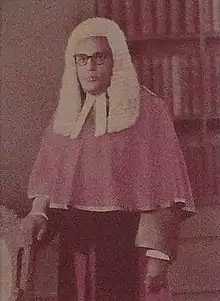H. W. Thambiah | |
|---|---|
 | |
| Puisne Justice of the Supreme Court of Ceylon | |
| In office 1960–1972 | |
| Sri Lankan High Commissioner to Canada | |
| In office September 1975 – December 1977 | |
| Personal details | |
| Born | 28 May 1906 Jaffna, Ceylon |
| Died | 1997 |
| Nationality | Sri Lankan |
| Alma mater | St. John's College, Jaffna Jaffna Central College University College, Colombo Ceylon Law College |
| Profession | Lawyer |
| Ethnicity | Ceylon Tamil |
Henry Wijeyakone Thambiah (also spelt Tambiah) (1906–1997) was a Ceylonese academic, diplomat, lawyer and judge, born in Sri Lanka during British colonial rule. He was a Commissioner of Assize, High Commissioner and judge of the Supreme Courts of Ceylon and Sierra Leone.[1][2]
Early life and family
Thambiah was born on 28 May 1906 in Jaffna in northern province of Ceylon.[3] He was the son of David Thambiah, a surveyor, and Thangamma, daughter of Dr William Thillayampalam Paul and sister of Dr S. C. Paul. Both his parents died when he was child.[4] Thambiah was educated at St. John's College, Jaffna and Jaffna Central College from where he passed the London matriculation in the first division.[3][4] His ambition was to be an engineer. After school he entered University College, Colombo and graduated in 1928 with a BSc (Hons) degree in maths and physics.[3][4] He taught physics for a year before becoming interest in the legal profession. He joined Ceylon Law College in 1930 and qualified as an attorney-at-law in 1933, winning a prize for coming first in the examinations.[3][4] He received a LLB (Hons) degree from the University of London in 1934, coming first amongst overseas students.[3]
Thambiah married Leela, daughter of C. D. A. Sherrard from Point Pedro. They have four children – Gulendran, Rajendran Jeyanathan, Rajeswari and Anthony Sudir.[3]
Career
After qualifying Thambiah practised law. Thambiah also worked as a visiting lecturer University of Ceylon and Ceylon Law College and an examiner at the Council of Legal Education between 1938 and 1953.[3][4][5] He obtained a PhD from the University of London in 1949 and in 1954 he was called to the Inner Temple.[3][4] In 1956 he became a QC.[3][4] He then joined the judicial service in 1956, serving as a Commissioner of Assize for five years before being appointed to the Supreme Court in 1960.[3] He was a Supreme Court judge for twelve years.
Later life
After retiring Thambiah moved to West Africa, serving as a judge on the Supreme Court of Sierra Leone and an appeals court judge in the Gambia.[3] He was awarded a LLD by the University of London in 1973 for his services to Sri Lankan law.[4] He was president of the Royal Asiatic Society of Sri Lanka from 1974 to 1976.[6] Thambiah returned to Sri Lankan in 1975 and started the Tamil section of the Law Faculty at the University of Colombo.[3] He served as the Sri Lankan High Commissioner to Canada from September 1975 to December 1977.[3][4] He then served as chair of the Law Commission.
Thambiah was awarded the Deshamanya title, the second highest civilian honour in Sri Lanka, in 1993.[3] He died in 1997 aged 91.[4]
Works
Thambiah wrote many books during his life:[3]
- Dominion of Ceylon
- Landlord and Tenant in Ceylon
- Law of Insolvency
- Laws and Customs of the Tamils of Jaffna (1950, Times of Ceylon)
- Laws and Customs of the Tamils of Ceylon (1954)
- Principles of Ceylon Law
- Sinhala Laws and Customs (1968)
- The Judicature of Sri Lanka in its Historical Aspects
See also
References
- ↑ Wickramasinghe, Chandra (1 June 2003). "Gulam Tambiah". The Island, Sri Lanka.
- ↑ "A shining example". Sunday Observer, Sri Lanka. 29 May 2011. Archived from the original on 25 March 2012. Retrieved 2 January 2012.
- 1 2 3 4 5 6 7 8 9 10 11 12 13 14 15 Arumugam, S. (1997). Dictionary of Biography of the Tamils of Ceylon. pp. 217–218.
- 1 2 3 4 5 6 7 8 9 10 Maniccavasagar, Chelvatamby (15 May 1997). "Dr. Tambiah – an outstanding lawyer and judge". Daily News.
- ↑ "Our History". University of Colombo. Archived from the original on 8 July 2012.
- ↑ "Past Presidents 1952–1999". Royal Asiatic Society of Sri Lanka.